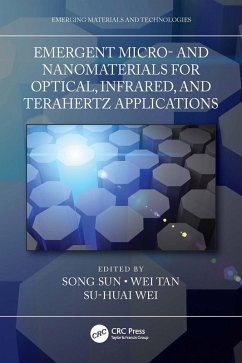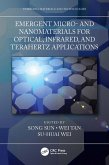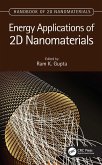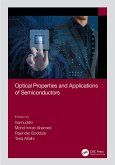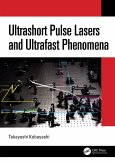Emergent Micro- and Nanomaterials for Optical, Infrared, and Terahertz Applications (eBook, PDF)
Redaktion: Sun, Song; Wei, Su-Huai; Tan, Wei
50,95 €
50,95 €
inkl. MwSt.
Sofort per Download lieferbar

25 °P sammeln
50,95 €
Als Download kaufen

50,95 €
inkl. MwSt.
Sofort per Download lieferbar

25 °P sammeln
Jetzt verschenken
Alle Infos zum eBook verschenken
50,95 €
inkl. MwSt.
Sofort per Download lieferbar
Alle Infos zum eBook verschenken

25 °P sammeln
Emergent Micro- and Nanomaterials for Optical, Infrared, and Terahertz Applications (eBook, PDF)
Redaktion: Sun, Song; Wei, Su-Huai; Tan, Wei
- Format: PDF
- Merkliste
- Auf die Merkliste
- Bewerten Bewerten
- Teilen
- Produkt teilen
- Produkterinnerung
- Produkterinnerung

Bitte loggen Sie sich zunächst in Ihr Kundenkonto ein oder registrieren Sie sich bei
bücher.de, um das eBook-Abo tolino select nutzen zu können.
Hier können Sie sich einloggen
Hier können Sie sich einloggen
Sie sind bereits eingeloggt. Klicken Sie auf 2. tolino select Abo, um fortzufahren.

Bitte loggen Sie sich zunächst in Ihr Kundenkonto ein oder registrieren Sie sich bei bücher.de, um das eBook-Abo tolino select nutzen zu können.
This book reviews developments in various emergent micro- and nanomaterials and their implementation in optical, infrared, and terahertz applications. The similarity, advantage, and limitation of each material is discussed and a comparative analysis of the various materials is offered.
- Geräte: PC
- ohne Kopierschutz
- eBook Hilfe
- Größe: 32.06MB
Andere Kunden interessierten sich auch für
![Emergent Micro- and Nanomaterials for Optical, Infrared, and Terahertz Applications (eBook, ePUB) Emergent Micro- and Nanomaterials for Optical, Infrared, and Terahertz Applications (eBook, ePUB)]() Emergent Micro- and Nanomaterials for Optical, Infrared, and Terahertz Applications (eBook, ePUB)50,95 €
Emergent Micro- and Nanomaterials for Optical, Infrared, and Terahertz Applications (eBook, ePUB)50,95 €![Energy Applications of 2D Nanomaterials (eBook, PDF) Energy Applications of 2D Nanomaterials (eBook, PDF)]() Energy Applications of 2D Nanomaterials (eBook, PDF)50,95 €
Energy Applications of 2D Nanomaterials (eBook, PDF)50,95 €![Optical Properties and Applications of Semiconductors (eBook, PDF) Optical Properties and Applications of Semiconductors (eBook, PDF)]() Optical Properties and Applications of Semiconductors (eBook, PDF)50,95 €
Optical Properties and Applications of Semiconductors (eBook, PDF)50,95 €![2D Materials for Infrared and Terahertz Detectors (eBook, PDF) 2D Materials for Infrared and Terahertz Detectors (eBook, PDF)]() Antoni Rogalski2D Materials for Infrared and Terahertz Detectors (eBook, PDF)46,95 €
Antoni Rogalski2D Materials for Infrared and Terahertz Detectors (eBook, PDF)46,95 €![Ultrashort Pulse Lasers and Ultrafast Phenomena (eBook, PDF) Ultrashort Pulse Lasers and Ultrafast Phenomena (eBook, PDF)]() Takayoshi KobayashiUltrashort Pulse Lasers and Ultrafast Phenomena (eBook, PDF)166,95 €
Takayoshi KobayashiUltrashort Pulse Lasers and Ultrafast Phenomena (eBook, PDF)166,95 €![Hydrogels (eBook, PDF) Hydrogels (eBook, PDF)]() Hydrogels (eBook, PDF)50,95 €
Hydrogels (eBook, PDF)50,95 €![Advances in Terahertz Source Technologies (eBook, PDF) Advances in Terahertz Source Technologies (eBook, PDF)]() Gun-Sik ParkAdvances in Terahertz Source Technologies (eBook, PDF)41,95 €
Gun-Sik ParkAdvances in Terahertz Source Technologies (eBook, PDF)41,95 €-
-
-
This book reviews developments in various emergent micro- and nanomaterials and their implementation in optical, infrared, and terahertz applications. The similarity, advantage, and limitation of each material is discussed and a comparative analysis of the various materials is offered.
Dieser Download kann aus rechtlichen Gründen nur mit Rechnungsadresse in A, B, BG, CY, CZ, D, DK, EW, E, FIN, F, GR, HR, H, IRL, I, LT, L, LR, M, NL, PL, P, R, S, SLO, SK ausgeliefert werden.
Produktdetails
- Produktdetails
- Verlag: Taylor & Francis
- Seitenzahl: 443
- Erscheinungstermin: 27. Oktober 2022
- Englisch
- ISBN-13: 9781000772593
- Artikelnr.: 65658136
- Verlag: Taylor & Francis
- Seitenzahl: 443
- Erscheinungstermin: 27. Oktober 2022
- Englisch
- ISBN-13: 9781000772593
- Artikelnr.: 65658136
Song Sun is Associate Professor at Microsystem and Terahertz Research Center, China Academy of Engineering Physics. He received his B.S. degree (first class honor, 2009) and PhD (2013) in Microelectronics from Nanyang Technological University, Singapore. Prof. Sun started his career at Institute of High Performance Computing, Agency for Science Technology and Research, Singapore in 2013, and joined Microsystem and Terahertz Research Center, China in 2017. Currently, he is also Adjunct Professor at University of Electronic Science and Technology, China. His expertise is in theoretical physics and computational electromagnetics with a strong background in Vacuum Electronics, Plasmonics, Nanophotonics, Metamaterial and Metasurface, Fluorescence Spontaneous Emission, and their applications. Prof. Sun has authored or cöauthored over 60 peer¿review journal papers, conference proceedings, and book chapters. He serves as an active member in IEEE, ACS, and Chinese Optical Society (senior member). Wei Tan is Associate Professor and Director of Terahertz Physics Department at Microsystem and Terahertz Research Center, China Academy of Engineering Physics. He received his B.S. degree (2007) and PhD (2012) in condensed matter physics from Tongji University, China. Prof. Tan started his career at Beijing Computational Science Research Center, China as a postdoctoral researcher in 2012, and joined Microsystem & Terahertz Research Center, China in 2014. His expertise is in the theoretical physics and modeling of electromagnetic wave-matter interactions with strong background in Terahertz Physics, Semiconductor Physics, Photonic Crystals and Metamaterials. His major area of research is terahertz wave generation and manipulation. Prof. Tan has authored or coauthored over 40 peer-review journal papers and conference proceedings, including an invited review article and a perspective article on the topic of spintronic terahertz emitter. Su-Huai Wei is Chair Professor and Head of the Materials and Energy Division of the Beijing Computational Science Research Center (CSRC). He received his B.S. in Physics from Fudan University in 1981 and Ph.D. from the College of William and Mary in 1985. He joined the National Renewable Energy Laboratory (NREL) in 1985 and was a Laboratory Fellow and Manager of the Theoretical Materials Science Group before he joined the CSRC in 2015. His research is focused on developing electronic structure theory of semiconductor compounds, alloys, and nanomaterials for optoelectronic and energy-related applications. He has published more than 500 papers in leading scientific journals, including more than 70 in Physical Review Letters. He is a Fellow of both of the American Physical Society and the Materials Research Society.
1. Introduction to optical, infrared and terahertz frequency bands. 2.
Theory of electromagnetic fields. 3. Theoretical Design of Nanomaterials
for Optical and Terahertz Applications. 4. Plasmonic Materials and their
Applications. 5. Artificial Metamaterials, Metasurfaces and Their
Applications. 6. Low Loss Dielectric Materials and Their Applications. 7.
Chiral Metamaterials and Their Applications. 8. Emerging Two-dimensional
Materials and Their Applications in Detection of Polarized Light. 9. Phase
Change Materials. 10. Magnetic and spintronic materials and their
applications. 11. Soft and Flexible Materials and their Applications. 12.
Piezoelectric materials and their applications. 13. Hybrid Perovskite
Materials and their Applications. 14. Near-Infrared Organic Materials for
Biological Applications.
Theory of electromagnetic fields. 3. Theoretical Design of Nanomaterials
for Optical and Terahertz Applications. 4. Plasmonic Materials and their
Applications. 5. Artificial Metamaterials, Metasurfaces and Their
Applications. 6. Low Loss Dielectric Materials and Their Applications. 7.
Chiral Metamaterials and Their Applications. 8. Emerging Two-dimensional
Materials and Their Applications in Detection of Polarized Light. 9. Phase
Change Materials. 10. Magnetic and spintronic materials and their
applications. 11. Soft and Flexible Materials and their Applications. 12.
Piezoelectric materials and their applications. 13. Hybrid Perovskite
Materials and their Applications. 14. Near-Infrared Organic Materials for
Biological Applications.
1. Introduction to optical, infrared and terahertz frequency bands. 2.
Theory of electromagnetic fields. 3. Theoretical Design of Nanomaterials
for Optical and Terahertz Applications. 4. Plasmonic Materials and their
Applications. 5. Artificial Metamaterials, Metasurfaces and Their
Applications. 6. Low Loss Dielectric Materials and Their Applications. 7.
Chiral Metamaterials and Their Applications. 8. Emerging Two-dimensional
Materials and Their Applications in Detection of Polarized Light. 9. Phase
Change Materials. 10. Magnetic and spintronic materials and their
applications. 11. Soft and Flexible Materials and their Applications. 12.
Piezoelectric materials and their applications. 13. Hybrid Perovskite
Materials and their Applications. 14. Near-Infrared Organic Materials for
Biological Applications.
Theory of electromagnetic fields. 3. Theoretical Design of Nanomaterials
for Optical and Terahertz Applications. 4. Plasmonic Materials and their
Applications. 5. Artificial Metamaterials, Metasurfaces and Their
Applications. 6. Low Loss Dielectric Materials and Their Applications. 7.
Chiral Metamaterials and Their Applications. 8. Emerging Two-dimensional
Materials and Their Applications in Detection of Polarized Light. 9. Phase
Change Materials. 10. Magnetic and spintronic materials and their
applications. 11. Soft and Flexible Materials and their Applications. 12.
Piezoelectric materials and their applications. 13. Hybrid Perovskite
Materials and their Applications. 14. Near-Infrared Organic Materials for
Biological Applications.
